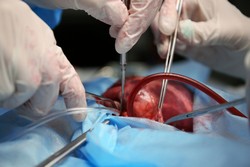A step closer to organ xenotransplantation
Organ xenotransplantation refers to obtaining donor organs such as heart or liver from another species. However, the attempt to produce suitable genetically modified pigs and new immunosuppressive treatments have been unsuccessful. A strong immune reaction against donor organs as well as spontaneous coagulation was triggered due to molecular incompatibilities between species. Recently, a ray of hope arose as researchers demonstrated the possibility of generating inter-species chimera animals such as a mouse-rat chimera through a process called interspecific embryo complementation. This process requires zygote genome editing after which chimeric-competent pluripotent stem cells (PSCs) are injected into the zygote. In this case, the mouse genome was edited and rat PSCs were injected into mice embryos. Chimerism refers to the condition where one organism has tissues containing genes of another organism. During the INTEREXT (Interspecies endotheliarization for organ xenotransplantation) project, scientists demonstrated a breakthrough proof of principle for mouse-rat chimera generation. To begin with, they obtained high quality and chimeric-competent rat cell lines after isolating 11 rat embryonic stem (ES) cell lines and producing three induced PSCs. These were injected into mice embryo. Researchers successfully produced eight mouse-rat interspecific chimera. However, none of these mice had a vascular system formed only from rat cells. The future of organ xenotransplantation relies on obtaining interspecific chimera, where chimerism can be successfully confined to a specific tissue type such as the vascular system. Success would mean that scientists could grow human organs in large animal models such as pigs. Treatment for diseases like hypercardiomyopathy and diabetes could then be personalised. The INTEREXT study has brought us a step closer to making this a reality.







